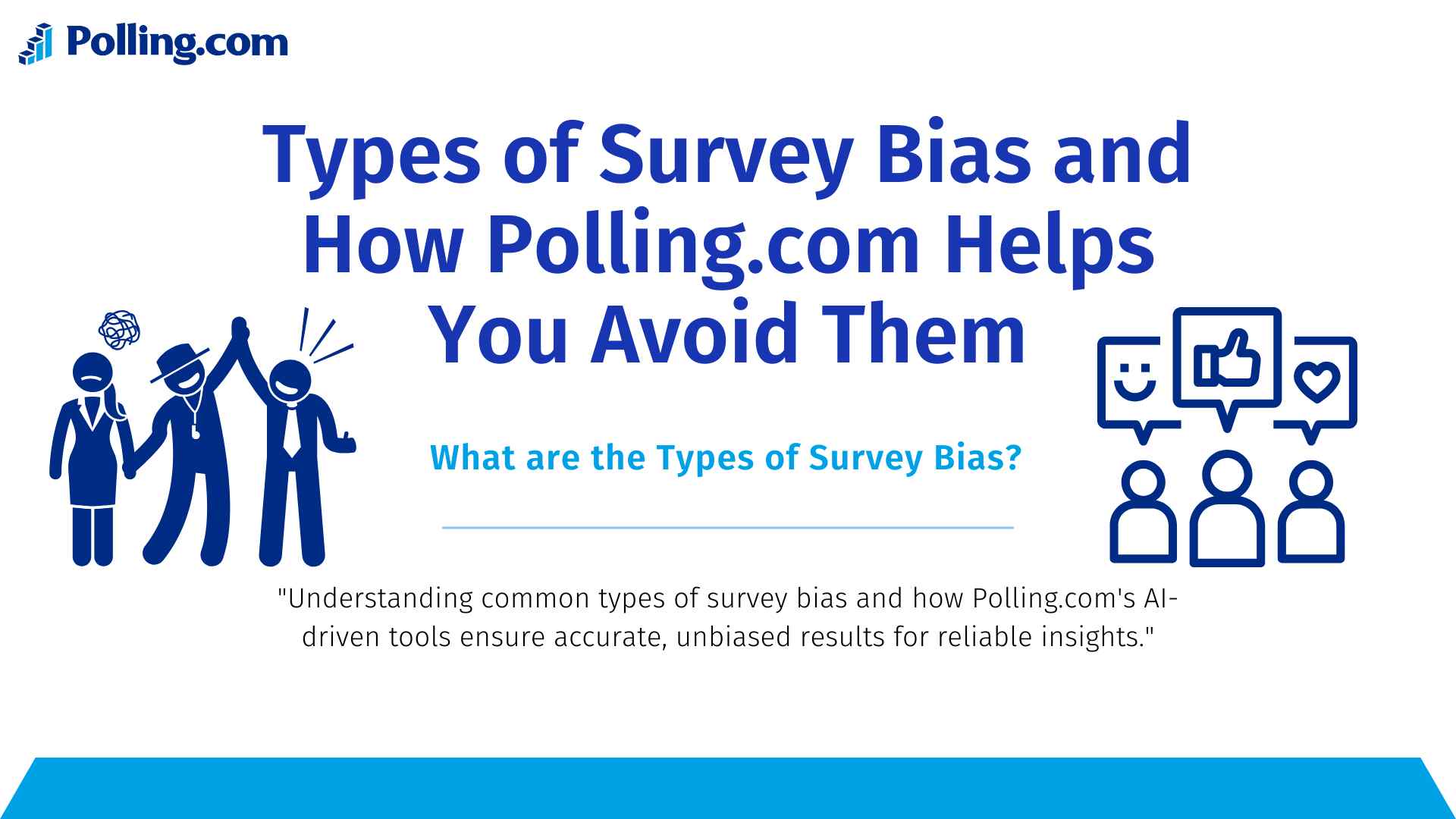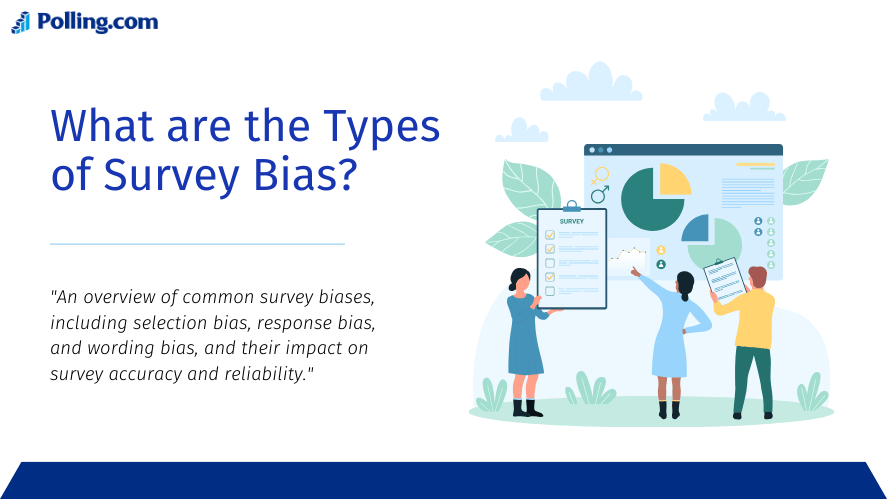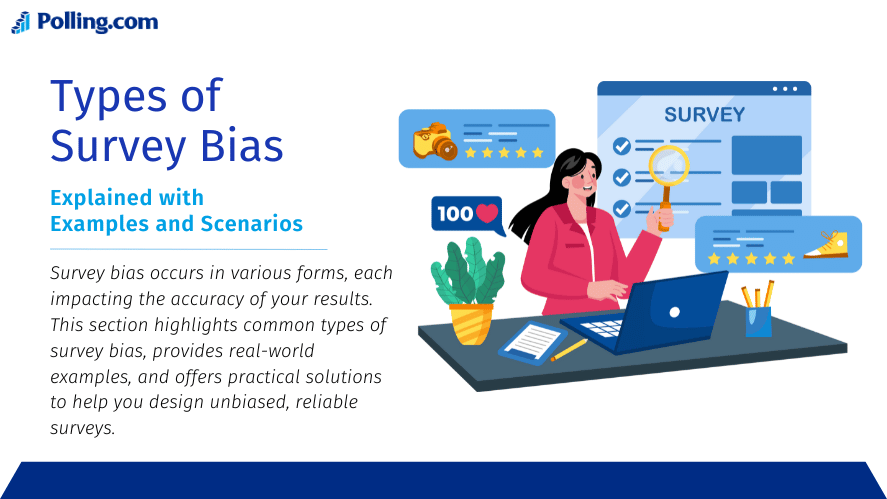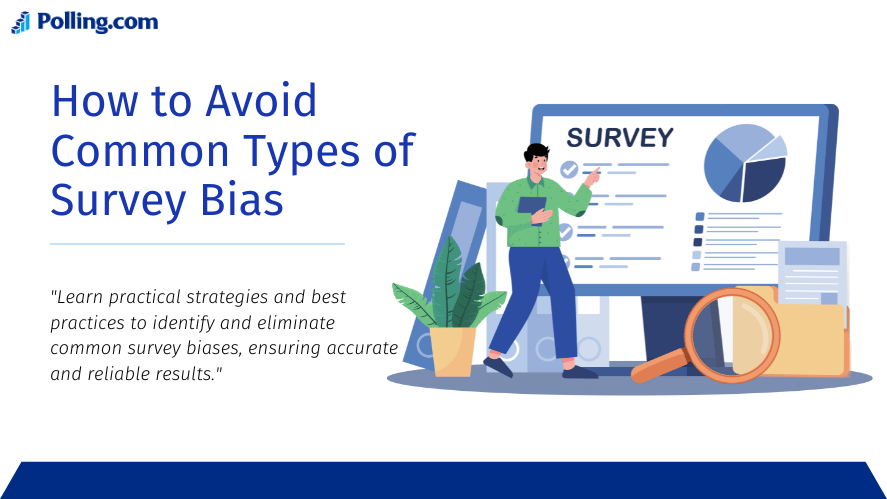
Types of Survey Bias and How Polling.com Helps You Avoid Them
Why Survey Bias Matters
Imagine a new product launched based on biased customer survey feedback, only to face a market failure. Or think of an election prediction that goes wildly wrong due to inaccurate data. These scenarios are common examples of the dangers of types of survey bias, where flaws in survey design or execution distort the truth.
Types of survey bias undermine decision-making and misrepresent reality, affecting market research, political polling, and customer feedback collection. Fortunately, with tools like Polling.com bias-free survey tools, you can create accurate, reliable surveys.
What Are the Types of Survey Bias?

Survey bias occurs when errors in survey design, sampling, or administration lead to inaccurate results. These types of survey bias create a distorted reflection of the population being studied, much like a foggy mirror.
Bias can emerge at any stage of the survey process, from question design to data collection. This issue is relevant across various fields, including:
- Market Research: Where skewed data leads to misguided product strategies.
- Political Polling: Misrepresentations that impact campaign decisions.
- Academic Studies: Where biased results undermine research validity.
For example, if a survey about smartphone usage includes only tech-savvy participants, it will exclude important segments, creating sampling bias. Understanding the types of survey bias is the first step to addressing it.
Types of Survey Bias: Explained with Examples and Scenarios

Response Bias
Definition
Response bias happens when respondents provide inaccurate answers, often to appear socially desirable or avoid judgment.
Scenario
A health survey asks:
“How often do you exercise per week?”
Respondents might overreport their activity levels to seem healthier than they are.
Improved Question Example
“On average, how many hours per week do you spend on physical activities, including walking, chores, or sports?”
How to Mitigate
- Guarantee respondent anonymity.
- Use neutral wording and avoid judgmental tones.
Sampling Bias
Definition
Sampling bias occurs when the selected sample doesn’t represent the target population.
Scenario
A survey about online shopping habits conducted only on e-commerce forums excludes non-online shoppers, skewing the results.
Improved Question Example
- Poor: “Which device do you typically use to shop online?”
- Improved: “How often do you shop online versus in physical stores?”
How to Mitigate
- Employ random sampling survey methods.
- Ensure demographic diversity, considering factors like age, location, and income.
Nonresponse Bias
Definition
Nonresponse bias arises when certain groups of people fail to respond, leaving their perspectives unrepresented.
Scenario
A restaurant sends out a survey to all diners but receives responses only from regular patrons, excluding feedback from first-time visitors.
Improved Question Example
“How would you rate your overall dining experience?”
How to Mitigate
- Offer participation incentives, such as discounts.
- Send reminders to encourage more responses.
Interviewer Bias
Definition
Interviewer bias occurs when an interviewer’s tone, phrasing, or behavior influences the respondent’s answers.
Scenario
A researcher asks:
“You think the new recycling program is beneficial, right?”
Improved Question Example
“How effective do you believe the new recycling program has been?”
How to Mitigate
- Use neutral language and tone.
- Opt for self-administered surveys when possible.
Question Order Bias
Definition
The order in which questions are presented can influence how respondents interpret and answer them.
Scenario
A political survey asks:
- “What concerns you most about unemployment?”
- “Do you support the current government?”
The first question primes respondents to think negatively, likely reducing their support for the government.
How to Mitigate
- Randomize question order where appropriate.
- Test survey flow during pilot phases.
Confirmation Bias
Definition
Occurs when questions are designed to affirm a specific hypothesis or expectation.
Scenario
A product feedback survey asks:
“What features do you love about our app?” (Assumes satisfaction.)
Improved Question Example
“What are the features you enjoy or find frustrating in our app?”
How to Mitigate
- Avoid assumptive or loaded language.
- Include options for neutral or negative feedback.
Selection Bias
Definition
Selection bias arises when survey participants don’t represent the intended population.
Scenario
A survey on job satisfaction only includes employees from top-performing departments, excluding less satisfied workers.
Improved Question Example
“How would you rate your overall job satisfaction, considering factors such as workload and the level of support provided?”
How to Mitigate
- Use stratified random sampling to include all subgroups.
- Analyze demographic data to ensure proper representation.
Leading Question Bias
Definition
Leading question bias occurs when the wording of a question suggests a specific answer.
Scenario
“How much did you enjoy our new product?” assumes the respondent enjoyed the product.
Improved Question Example
“How would you rate your experience with our new product?”
How to Mitigate
Acquiescence Bias: A Common Type of Survey Bias
Definition
Acquiescence bias occurs when respondents agree with statements, regardless of their true feelings. This skews results, as responses reflect agreement rather than authentic opinions.
Scenario
A survey asks:
“Do you agree that customer service is excellent?”
Respondents may agree out of habit or to avoid conflict, even if they have reservations.
Sample Question Example
- Poor: “Do you agree that customer service is excellent?”
- Improved: “How do you evaluate the overall quality of our customer service?”
How to Mitigate This Type of Survey Bias
- Use balanced scales (e.g., “Strongly disagree” to “Strongly agree”).
- Mix positively and negatively worded statements.
Recall Bias
Definition
Recall bias arises when respondents struggle to accurately remember past events, leading to inaccurate or incomplete responses.
Scenario
A travel survey asks:
“How often have you traveled by air in the last five years?”
Respondents may provide rough estimates that are far from accurate.
Sample Question Example
- Poor: “How often have you traveled by air in the last five years?”
- Improved: “How many trips by air have you made over the past year?”
How to Mitigate
- Focus on recent and specific timeframes.
- Use reference points (e.g., “Since last summer…”) to aid memory recall.
Cultural Bias: An Overlooked Type of Survey Bias
Definition
Cultural bias occurs when surveys assume respondents share the same cultural norms, leading to misinterpretation or exclusion.
Scenario
A global survey asks:
“How do you celebrate Thanksgiving?”
This assumes familiarity with a culturally specific event, alienating respondents from different backgrounds.
Sample Question Example
- Poor: “How do you celebrate Thanksgiving?”
- Improved: “What festivals or holidays do you celebrate, and how?”
How to Mitigate
- Tailor questions to the target audience’s culture.
- Pretest surveys with culturally diverse groups to identify potential biases.
Sponsorship Bias
Definition
Sponsorship bias arises when respondents’ answers are influenced by their perception of the survey’s sponsor.
Scenario
A survey sponsored by an environmental organization asks:
“Do you support clean energy initiatives?”
Respondents may feel compelled to align with the sponsor’s stance.
Sample Question Example
- Poor: “Do you support clean energy initiatives?”
- Improved: “What are your thoughts on clean energy initiatives?”
How to Mitigate
- Disclose sponsorship transparently.
- Assure respondents that their answers are confidential and unbiased.
Order Effect Bias: A Key Type of Survey Bias
Definition
Order effect bias occurs when the placement of questions or response options influences how respondents answer.
Scenario
In a restaurant survey, the first menu item listed is often chosen as the favorite, simply due to its position.
Sample Question Example
- Poor: “Which dish from the following options do you like the most?” (List always starts with the same item.)
- Improved: “Which dish from the following options do you like the most?” (Rotate the order of dishes for each respondent.)
How to Mitigate
- Randomize response options to prevent position bias.
- Balance question order across surveys.
How to Build a Bias-Free Survey Using Polling.com

Building a bias-free survey requires meticulous planning and the right tools. Here are some actionable strategies to minimize bias:
1. Use Pre-Designed Templates for Neutral Questions
Polling.com provides templates crafted to minimize bias through balanced, neutral language.
2. Employ Randomized Sampling Techniques
Avoid sampling bias by reaching diverse respondents through randomized sampling.
3. Leverage AI Analytics to Detect Bias
Polling.com’s AI tools analyze survey design in real-time, flagging potential biases before data collection begins.
4. Pilot-Test Your Survey Design
Run small-scale tests to identify issues like leading question bias or question order bias before full deployment.
Why Polling.com Is the Best Tool for Avoiding Types of Survey Bias
The success of your survey depends on accurate data. Polling.com simplifies the process of avoiding bias with:
- User-Friendly Interfaces: Easily create and deploy bias-free surveys.
- Real-Time Analytics: Identify and correct biases during survey creation.
- Scalability: Use Polling.com for small or large-scale projects with equal ease.
Choosing the right tool ensures your survey data reflects reality, not distortion.
Conclusion
Survey bias undermines data integrity, leading to poor decisions and wasted resources. From understanding acquiescence bias to mitigating order effect bias, addressing these issues is essential for reliable results.
With tools like Polling.com bias-free survey tools, you can design surveys that capture accurate, actionable insights. Say goodbye to distorted data and hello to surveys you can trust choose Polling.com today.
